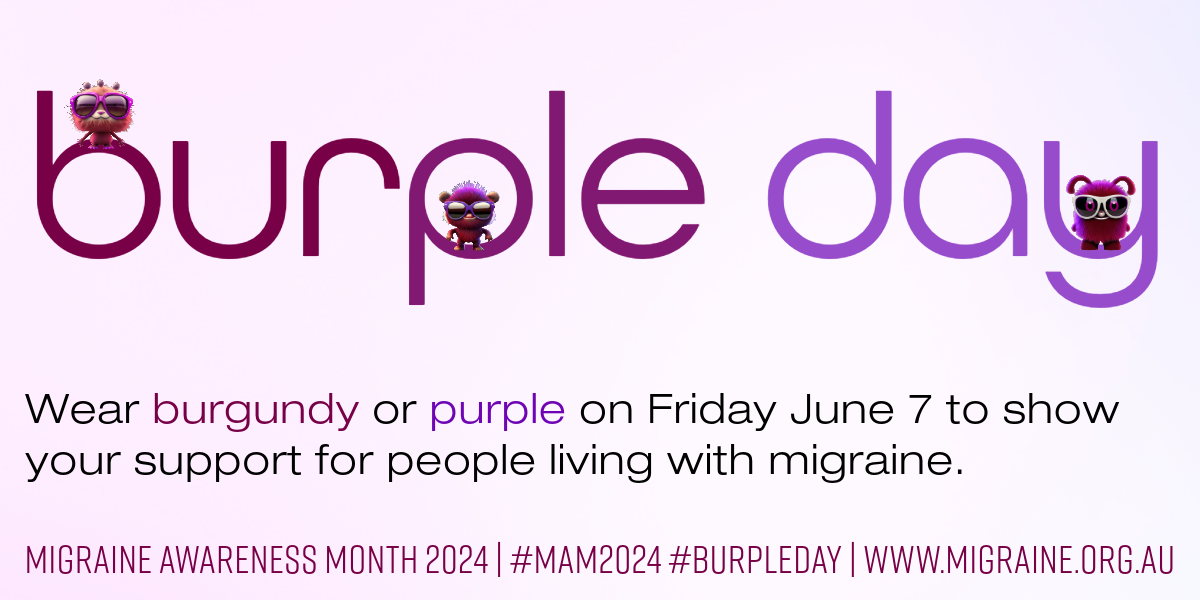Migraine Australia is launching a new awareness day for migraine, Burple Day, to be held on the first Friday in June.
Migraine Awareness Month is held in June each year. It is the major annual awareness activity of the global migraine community with over 35 countries conducting activities throughout the month. Migraine Australia, the only patient body supporting Australians living with migraine, has led the month of activities each year since 2020.
Migraine is not a headache… at all.
Migraine is really common. 1 in 5 Australians, or five million people, live with some form of migraine disorder. And the most important thing each and every one of those five million people living with migraine need to know is that it is not a headache, nothing about migraine is your fault, and because it’s genetic, you cannot cure it.
Migraine is a complex genetic neurological disorder that has a wide spectrum of presentations. It is a form of sensory processing disorder in which the migraine brain overreacts to things. Migraine physiology is complex, but what we know is that when ‘triggered’ by a sensory overload, the migraine brain gets over-excited and triggers a ‘storm’ of chemicals that cause the migraine attack. Migraine brains are hyper-reactive all the time – not just during attacks – which can be useful for things like being fast learners. But like any kind of engine that is engineered to run fast, it is easy to overheat a migraine brain, and that’s when you get migraine attacks.
Each person living with migraine has a slightly different combination of symptoms, triggers and treatments. But the stigma that migraine is ‘just a headache’ is so entrenched that people living with migraine are often bullied into not mentioning it.
Treated as hypochondriacs or drug seekers by doctors and other health workers, bludgers chucking sickies at work, and lazy whingers at home, it is easier to just suffer through it than ask for help. And, if someone does speak up about their migraine, they are often met by a well meaning person telling them it’s their fault, and they just need to change some behaviour or something in their diet and they’ll be fine.
Migraine Awareness Month is a great time for people to talk about their migraine with friends, family and loved ones, and learn about more about this very common disability, to try and bust some of that stigma. And I need to do that too, as the founder of both this publication and the founder of Migraine Australia, and put my truth out there. I do that knowing full well that this piece is likely to be responded to with a bunch of oh-so-helpful suggestions like ‘are you getting enough sleep’ or ‘you just need to drink more water’.
I am in the top 1% of severe presentations of migraine. It’s not the kind of 1% I’d like to be part of, let me assure you.
My attacks, known as hemiplegic attacks, cause stroke like symptoms. Numbness, weakness, loss of motor function, loss of speech, inability to swallow, impaired cognitive function, impaired eyesight, incontinence, migraineous corpalgia (body pain) and a long list of stuff not working right. And that’s an average attack. If it’s a bad attack or has brainstem aura, then throw in severe chest pain, decreased breathing, and – very rarely, but possible – coma.
I am frequently in hospital. I don’t get much headache.
And I am, by far, not the worst I can tell you about. For example, there is a boy in Perth who is in what’s called ‘status’ – that is, stuck in the attack phase of the migraine cycle for more than 4 days. He’s been stuck there for years, barely able to function let alone attend school on a regular basis. The last distressing call I got from his mum just a few weeks ago was about him losing his vision. There doesn’t seem to be anything anyone can do for him, and the new drugs that have changed my life aren’t yet approved for children.
New drugs give hope but are out of reach for most
Ironically, as my work is probably at its highest peak with the still mind blowing success of this little website, my migraine is at its worst in years. I’ve been really great for five years, after ten years of being so disabled I required carers and was dependent on Disability Support Pension. The dramatic life-change was thanks to a new class of drugs called CGRP antagonists.
The scientific understanding of what migraine is has changed dramatically in recent years, and a whole array of new medications, devices and treatments are now available. CGRP stands for Calcitonin Gene Related Peptide – a natural chemical that everyone has, but it surges during a migraine attack. The new drugs block the CGRP, and effectively block the migraine attack for most people.
Unfortunately, the new medications are out of reach for most as they are not on the PBS. Three new preventative treatments are available on the PBS only for those significantly debilitated by migraine (over 15 migraine affected days per month) who have failed at least three older treatments and are under the care of a neurologist.
I meet all those criteria and then some, but my drug, Aimovig, which was the first of these new ‘made for migraine’ medications released in 2018, is not on the PBS for anyone. It costs me $695 every four weeks, and you better believe that gets paid before the rent.
I made the mistake last year of rationing it for a while by taking it every six weeks, and then stopping it, because I couldn’t afford it when I unexpectedly lost my job. I was promptly reminded of how very much I need this medication to function. Add in a little stress and a dash of being a woman of a certain age, and it’s proving to be hard to get back to attack free, but I am still considerably better than life without the medication.
An even newer drug approved by the TGA last year called Nurtec promises to really change the migraine landscape. It’s a wafer-style tablet that you can take either acutely – when you get an attack – or preventatively, either on an ongoing basis, or just if you think you’re going to be triggered. So, if you know you get attacks with your period or during exams, you can just take it a couple of days before hand. Or if you have something big on, like say you’re getting married, you can just take the medication before that event – you don’t need to be on it all the time.
But, of course, that was rejected from the PBS too. Not because the medications aren’t effective – they amazingly are – there’s just too many people that live with migraine and the Government doesn’t want to pay.
You can get your GP to prescribe these medications for you if you can afford them, including Nurtec, which retails at around $300 for a packet of 8. If you have the money they are absolutely worth trying. But most people don’t have the money.
But what’s a burple?
So this is all a bit sad and depressing really. Migraine is awful, lots of people have it, people who don’t have it think we’re making it up, and there’s good drugs available for the first time ever – but you can only have them if you’re rich because the government doesn’t want to pay for the millions of (mostly female) Australians and their silly ‘headaches’.
Enter, stage left, the burples.

In many parts of the world, there is a ‘wear it purple’ day for migraine on June 1 to kick off Migraine Awareness Month activities. However, as there was already a successful and important ‘Wear It Purple’ day for LGBTIQ+ young people in Australia, Migraine Australia previously skipped that part of the global program, focusing on ‘Shades for Migraine’ day on June 21.
In the lead up to this year’s Migraine Awareness Month the team of volunteers that run Migraine Australia revisited whether they wanted to have a day of action early in the month to get people engaged, and whether we should have a burgundy or purple day for people to show their support. We already have a number of buildings and landmarks that will light up in burgundy or purple for Migraine Awareness Month, but wanted to extend that to something everyone could do.
One thing led to another, quite literally in burgundy and purple getting smooshed together, and Burple Day was born.
So the legend goes, Burples are tiny burgundy and purple creatures that live in dark places and always wear their sunglasses, just like many people with migraine. They thought Burple Day was for them, so kinda took over. Bennie, Bindi and Billie are very keen to let people know that migraine is not a headache and there is no ‘s’ in ‘migraine’.
(In truth, I just put the word ‘burple’ into an AI image generator, and out popped a little creature… creative minds did then their thing and now we have Burples to help us raise awareness of migraine. But the story is fun, and a lot more interesting than just lecturing you about the $36 billion dollars a year that migraine costs the economy, so let’s go with that.)
All Australians can show their support for people with migraine by wearing burgundy and purple on ‘Burple Day’, the first Friday in June which this year is June 7.
Find out more about migraine, Burple Day, and Migraine Awareness Month, on the Migraine Australia site www.migraine.org.au
Something going on in your part of the New England people should know about? Let us know by emailing newsdesk@netimes.com.au


